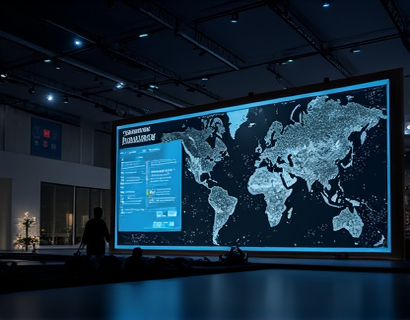Maximizing Ucosystem Efficiency with Customized External Solutions
In today's fast-paced business environment, the Ucosystem has become a critical component for organizations aiming to thrive. The Ucosystem encompasses a network of interconnected entities including suppliers, partners, customers, and service providers, all working together to create value. However, achieving optimal efficiency and collaboration within this complex network can be challenging. This is where the strategic implementation of customized external solutions comes into play, offering a pathway to enhance operations, foster better collaboration, and drive growth.
The concept of a Ucosystem is rooted in the understanding that no single entity can operate in isolation. By leveraging external solutions tailored to specific needs, businesses can bridge gaps, streamline processes, and unlock new opportunities. These solutions are designed to integrate seamlessly with existing systems, providing a cohesive and efficient experience for all stakeholders.
Understanding the Importance of External Solutions
External solutions play a pivotal role in maximizing Ucosystem efficiency. They offer specialized services that can address specific pain points or areas for improvement within the Ucosystem. For instance, a business may require advanced analytics to gain deeper insights into customer behavior or need robust cybersecurity measures to protect sensitive data. Customized external solutions can provide these capabilities, ensuring that the Ucosystem operates at its best.
One of the key benefits of external solutions is their ability to bring in fresh perspectives and innovative technologies. These solutions are often developed by experts in their respective fields, ensuring that they are up-to-date with the latest trends and best practices. By integrating these solutions, businesses can stay competitive and adapt to changing market conditions more effectively.
Enhancing Collaboration Through Tailored Services
Collaboration is at the heart of a thriving Ucosystem. Customized external solutions are designed to facilitate better communication and cooperation among various stakeholders. For example, project management tools can help align teams across different locations, ensuring that everyone is on the same page and working towards common goals. These tools provide real-time updates, task assignments, and progress tracking, reducing misunderstandings and delays.
Another area where tailored services excel is in fostering partnerships. By offering platforms that simplify the process of finding and onboarding new partners, businesses can expand their reach and access a broader range of resources. These platforms often include features such as comprehensive profiles, review systems, and negotiation tools, making it easier to identify and select the right partners for specific projects or initiatives.
Driving Growth with Strategic External Solutions
Growth is a primary objective for most businesses, and external solutions can significantly contribute to this goal. By optimizing operations and enhancing collaboration, these solutions help businesses scale more efficiently. For instance, supply chain management solutions can streamline the flow of goods and services, reducing costs and improving delivery times. This not only enhances customer satisfaction but also frees up resources that can be redirected towards other growth initiatives.
Marketing and sales enablement tools are another critical component of external solutions. These tools provide businesses with the resources and insights needed to effectively reach and engage with their target audience. From automated email campaigns to data-driven marketing analytics, these solutions help businesses refine their strategies and achieve better results.
Case Study: Improving Operational Efficiency
Consider a manufacturing company that faced challenges in coordinating its supply chain. The company implemented a customized supply chain management solution that integrated with its existing ERP system. This solution provided real-time visibility into inventory levels, supplier performance, and production schedules. As a result, the company was able to reduce lead times by 30% and lower inventory costs by 20%. These improvements not only enhanced operational efficiency but also contributed to increased profitability.
Case Study: Enhancing Customer Experience
A retail business struggled with managing customer feedback and personalizing the shopping experience. By adopting a customized customer relationship management (CRM) solution, the business gained a centralized platform to track customer interactions, preferences, and purchase history. This allowed the company to deliver more personalized recommendations and support, leading to a 25% increase in customer retention and a 15% rise in sales.
Selecting the Right External Solutions
Choosing the right external solutions requires a strategic approach. Businesses should start by conducting a thorough assessment of their current Ucosystem, identifying areas of strength and weakness. This self-evaluation will help pinpoint specific needs and opportunities for improvement. It's also essential to define clear objectives for what the external solutions should achieve, whether it's improving efficiency, enhancing collaboration, or driving growth.
Once the needs and objectives are clear, the next step is to research potential providers. This involves evaluating their expertise, reputation, and the specific solutions they offer. It's crucial to look beyond price and consider factors such as customization options, integration capabilities, and ongoing support. Engaging with potential providers through demos and trials can provide valuable insights into how well their solutions align with the business's requirements.
Implementing and Integrating External Solutions
Successful implementation of external solutions requires careful planning and execution. The first step is to establish a dedicated project team responsible for overseeing the integration process. This team should include representatives from various departments to ensure a holistic approach and minimize disruptions.
During the integration phase, it's important to maintain open communication channels between the internal team and the external provider. Regular check-ins and progress updates help address any issues promptly and ensure that the solution is meeting the desired outcomes. Additionally, providing comprehensive training to end-users is crucial for maximizing the benefits of the new solution.
Overcoming Common Challenges
One common challenge when implementing external solutions is resistance from within the organization. Change can be met with skepticism, especially if employees are accustomed to existing processes. To overcome this, it's essential to communicate the benefits clearly and involve key stakeholders in the decision-making process. Demonstrating how the new solution will improve their work and contribute to the organization's goals can help gain buy-in.
Technical integration can also pose challenges, particularly when dealing with legacy systems. In such cases, working closely with the provider to develop a tailored integration strategy is vital. This may involve custom development or the use of middleware to ensure seamless connectivity. Investing in robust testing and quality assurance processes can help identify and resolve issues before they impact operations.
Measuring the Impact of External Solutions
To truly maximize the efficiency of the Ucosystem, it's crucial to measure the impact of the external solutions implemented. This involves setting key performance indicators (KPIs) that align with the initial objectives. For example, if the goal was to reduce operational costs, KPIs might include cost savings per unit, reduction in waste, or improved resource utilization.
Regular monitoring and reporting on these KPIs provide valuable insights into the effectiveness of the solutions. This data can be used to make informed decisions about further optimizations or adjustments. Continuous improvement is key to sustaining the benefits over time and adapting to evolving business needs.
Long-Term Benefits and Sustainability
The benefits of customized external solutions extend beyond immediate improvements. By establishing a strong foundation of efficiency and collaboration, businesses can create a sustainable Ucosystem that supports long-term growth. These solutions foster a culture of innovation and adaptability, enabling organizations to respond more effectively to market changes and capitalize on new opportunities.
Moreover, the relationships built through these solutions can lead to strategic partnerships and collaborations that drive further value. The network effect of a well-optimized Ucosystem can open doors to new markets, enhance brand reputation, and attract top talent.
In conclusion, maximizing Ucosystem efficiency through customized external solutions is a strategic investment that can yield significant returns. By enhancing collaboration, driving growth, and fostering innovation, businesses can position themselves for success in an increasingly interconnected world.











































